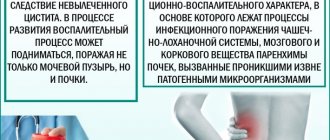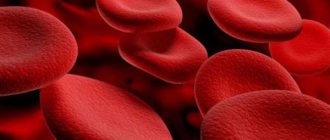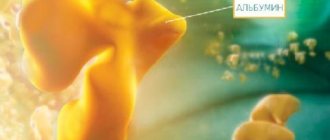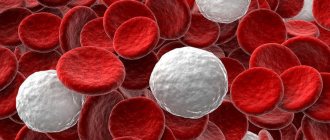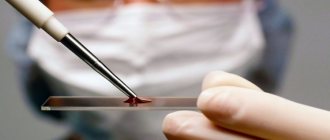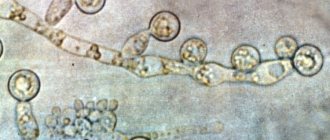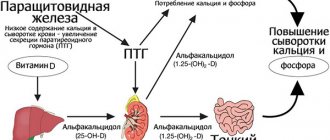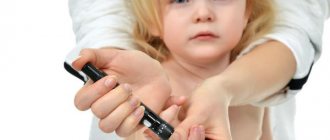You are here: Blood test -
Hemoglobin -
High hemoglobin in women
- Etiology
- Symptoms
- Diagnostics
- Treatment
- Possible complications
- Prevention and prognosis
High hemoglobin in women is a deviation from the norm, which is detected only by the results of a general clinical analysis of venous or capillary blood. It is noteworthy that in women this anomaly is considered quite rare.
The disorder is often caused by a limited range of diseases. The possibility of the influence of physiological or completely harmless reasons cannot be excluded.
The clinical picture is nonspecific and often goes unnoticed. The main symptoms are considered to be redness or paleness of the skin, pain in the muscles, joints and bones, severe dizziness, complete or partial loss of appetite.
The main diagnostic procedure is a general blood test, but this is not enough to establish the root cause of the pathology, so the diagnostic process must take an integrated approach.
Treatment of high hemoglobin in the blood is limited to conservative methods, in particular diet, medication and the use of alternative medicine.
Etiology
The concentration of the main element of red blood cells is one of the most important blood indicators. The norm for a healthy adult woman can range from 115 to 140 g/l. When the level increases to 150–170 g/l, urgent medical attention is required.
As for women during pregnancy, normal values will be 110–120 g/l. In such situations, the level of hemoglobin increases extremely rarely; a decrease is often observed.
The causes of increased hemoglobin in women are very diverse; they are usually divided into several large groups. The first category of provocateurs includes diseases and pathological conditions, including:
- extensive burns;
- malignant tumors;
- diabetes;
- cardiovascular failure;
- intestinal obstruction;
- dysbacteriosis and hypovitaminosis;
- infectious diseases of the gastrointestinal tract;
- pulmonary and respiratory failure;
- volvulus;
- kidney pathologies;
- hypertonic disease;
- congenital cardiac anomalies;
- chronic oxygen deficiency - hypoxia;
- intestinal obstruction;
- pathologies of an autoimmune nature;
- Vaquez's disease.
The deviation does not always have a pathological basis; it is not uncommon for it to develop in a completely healthy person. Physiological causes of high hemoglobin:
- engaging in strenuous sports;
- consumption of insufficient amount of liquid per day - the daily norm is at least 2 liters;
- the period of bearing a child, especially in the 2nd and 3rd trimester;
- irrational use of drugs, for example, diuretics and immunoglobulins, glucocorticosteroids and immunosuppressants;
- hormonal imbalance;
- long-term physical activity;
- chronic stressful situations;
- living or prolonged stay in high mountain areas;
- hot climate;
- abuse of bad habits, in particular smoking;
- secretion of a large amount of sweat.
Clinicians believe that genetic predisposition may act as a predisposing factor. Knowing this, women should regularly donate blood for subsequent laboratory tests.
Women need to remember that the possibility of a false increase in the concentration of iron-containing protein cannot be ruled out - the result of a laboratory test may be affected by the time of day when the blood was taken. In the morning, hemoglobin levels are higher than in the afternoon.
Hematologists involved in deciphering the results note that the causes of increased hemoglobin may be liver damage or drug overdose.
High hemoglobin
Symptoms
Elevated hemoglobin in women has a nonspecific and mild clinical picture, so often characteristic signs go unnoticed or are masked as manifestations of the underlying disease.
Clinicians identify the main symptoms that occur regardless of the etiological factor. The following signs indicate an increase in hemoglobin concentration in the blood:
- local redness of the skin, which alternates with areas of pallor;
- general malaise and weakness;
- constant drowsiness;
- body aches;
- dizziness;
- muscle, joint and headaches;
- dry mucous membranes and skin;
- emotional instability;
- increase in blood tone indicators;
- thirst and shortness of breath;
- increased irritability;
- decreased ability to work;
- partial or complete lack of appetite;
- excessively painful and prolonged menstruation;
- the appearance of bruises and hemorrhages even with minor trauma to the skin;
- bloating of veins;
- violation of the act of defecation and urination;
- coldness of the fingertips of the upper and lower extremities;
- nausea without vomiting;
- absent-mindedness and memory impairment;
- decreased hearing and visual acuity;
- pain and bloating in the abdomen.
The severity of clinical manifestations depends on how high the hemoglobin level is in women. If symptoms occur, you should seek medical help as soon as possible.
What does increased hemoglobin mean?
For most people, elevated hemoglobin does not cause concern, but they are not aware of the symptoms and reasons for the increase in the concentration of this protein. As a result, the body is exposed to danger, as the risk of developing serious diseases increases. A high concentration of hemoglobin is accompanied by thickening of the blood, which contributes to the formation of blood clots, blockage of blood vessels, and disruption of normal oxygen transport.
In the absence of therapy, thrombophlebitis develops (growths form on the vessels), followed by thromboembolism, which causes disruption of the functioning of many organs due to the attachment of blood clots to them. High hemoglobin levels cause fetal growth retardation, confusion, and dull or completely destroy cognitive abilities. Increased blood viscosity due to the high content of red blood cells and complex protein greatly increases the risk of strokes and heart attacks.
An imbalance in the composition of the blood, in addition, triggers a change in the shape of red blood cells; this disease is called sickle anemia, since the red cells take on a crescent shape and lose the ability to perform their functions. Increased iron-containing protein affects the general condition of the body, causing drowsiness, lack of appetite, weakness, fatigue, decreased performance, and dizziness. If a person's condition does not change for a long time, the consequences will be very serious.
- How to choose a backpack for a first grader
- What to cook from chicken fillet quickly and tasty. Chicken fillet recipes with photos
- Therapeutic diet for hemorrhoids
Diagnostics
Detection of increased hemoglobin in women is carried out only using a general clinical blood test; biological material is collected from a finger or from a vein. The procedure is generally accepted and is not prohibited during pregnancy. There is no need to prepare for the analysis in advance.
The information obtained will not be enough to find out why hemoglobin is increased in the blood of women - a comprehensive examination of the body is necessary.
General diagnostics begins with the following manipulations:
- studying the patient's medical history;
- familiarization with family history;
- collection and analysis of life history - information regarding lifestyle, food habits and medication intake is important for the doctor;
- a thorough physical examination;
- assessment of the condition of the skin and mucous membranes;
- measuring temperature, heart rate and blood tone;
- a detailed survey will indicate to the specialist the complete symptomatic picture, and can often indicate the provoking disease.
Additional laboratory and instrumental diagnostics are selected individually, in accordance with complaints and data obtained during previous diagnostic measures.
Hemoglobin norm for women
Treatment
To lower the level of hemoglobin in the blood, it is necessary to eliminate the pathological etiological factor. Treatment can be conservative, surgical or complex.
To quickly thin the blood, patients are prescribed the following medications:
- "Courantil";
- "Aspirin";
- "Trental";
- "Cardiomagnyl";
- salicylic acid.
It is important to consider that drug therapy for pregnant women is carried out under the strict supervision of the attending physician and obstetrician-gynecologist.
The basis of treatment is a diet for high hemoglobin, which involves complete avoidance of the following foods:
- red meat;
- alcohol;
- cereals and coffee;
- vegetables, fruits and red berries;
- confectionery;
- carbonated drinks;
- butter and margarine.
You should limit your consumption of fatty meats and fish, sugar and sweets, fried, salty and spicy foods.
A diet with high hemoglobin does not prohibit eating the following foods:
- dietary types of meat and fish;
- milk products;
- cottage cheese and hard cheese;
- seafood;
- green tea;
- wheat bread;
- potato;
- citrus.
An increase in hemoglobin is corrected using the following methods:
- folk remedies;
- hirudotherapy;
- electrophoresis;
- bloodletting;
- taking mumiyo.
What to do if hemoglobin is elevated
It is possible to reduce the production of an element by eliminating the cause of the development of the deviation. If this symptom was caused by any pathology, then it is necessary to treat the underlying disease. To lower protein levels, doctors prescribe complex therapy, which includes:
- Diet. The patient is advised to avoid eating foods that increase iron protein levels or retain iron in the body.
- Taking medications. Prescribed exclusively by a doctor and after a blood test.
- Hirudotherapy. Treatment with leeches brings a positive effect, since the saliva of these creatures contains substances that normalize the composition of the blood. Special components reduce plasma viscosity and prevent blood from clotting too quickly.
- Blood transfusion. The procedure involves taking blood, freeing it from red blood cells and returning it to the patient. If the patient is not sick, it is better to control elevated hemoglobin by donating blood.
- Folk methods. Often alternative medicine is no less effective than medications.
Medications
Drug therapy involves taking agents that prevent platelet aggregation (clumping), which reduces the risk of blood clots, and dilate blood vessels. Medicines against high hemoglobin are allowed to be used only after consulting a doctor, since their improper use can lead to serious complications. For elevated iron protein levels, the following blood thinners are prescribed:
- Chimes. The drug inhibits the activity of platelet enzymes. Its antiagrenant effect is similar to aspirin. In addition, Curantil provides a coronary dilation effect (expands the lumens of the coronary vessels of the heart during an attack of angina). The drug is well absorbed by the digestive tract (37-66%), while its maximum concentration in the body is achieved within 1-1.5 hours. The advantages of the medicine include the possibility of taking it by people with aspirin intolerance and pregnant women. The downside is that it is prohibited to use the drug by people with high acidity and low blood pressure.
- Trental. Reduces platelet aggregation and prevents red blood cells from sticking to the walls of blood vessels, reduces blood viscosity. Pentoxifylline, which is part of the medication, thins the blood, normalizes its chemical composition and slightly dilates blood vessels. The advantage of the drug is its effectiveness and beneficial effect on the course of metabolic processes in the central nervous system and the functioning of the heart. The disadvantages include the likelihood of developing brittle nails, xerostomia, anorexia, and visual impairment due to prolonged treatment.
- Aspirin. The drug is often used to prevent blood clots. It is perfectly absorbed by the stomach and quickly gives a therapeutic effect (half an hour after administration). Aspirin can provoke the appearance of peptic ulcers, so you should take it with plenty of water/milk. The detrimental effect on the gastric mucosa is the main disadvantage of the drug. The advantages are its availability and the rapid positive effect that Aspirin has on the cardiovascular system.
- Clopidogrel. The drug inhibits platelet aggregation and reduces elevated hemoglobin levels. The doctor may prescribe clopidogrel for ischemic disorders, atherosclerosis, implantation of a coronary stent, etc. The advantage of the medication is the minimal risk of side effects. The disadvantage of Clopidogrel is the high probability of bleeding due to surgical interventions or a disrupted hemostatic system.
- Ticlid/Ticlopidine. It is prescribed for the prevention of ischemic disorders in atherosclerosis of cerebral vessels, during rehabilitation after myocardial infarction, in diabetes mellitus, etc. The advantage of the drug is its high efficiency compared to analogues, including aspirin. The disadvantage of the drug is the need to strictly adhere to the dosage, otherwise severe complications may develop in the form of hemorrhagic syndrome, etc.
Proper nutrition for high hemoglobin
Since elevated protein levels can be caused by dehydration, it is important to maintain daily fluid intake to treat the symptom. In addition, it is important to balance your diet by including healthy foods that will help stabilize your blood composition, replenish the lack of vitamins, and restore lost fluid. These types of food include fish, legumes, seafood, and greens.
In addition, if the level of iron-containing protein is high, the menu should be supplemented with chicken meat, dairy products and eggs. It is important that the food consumed is not very fatty. Since many common foods increase the hemoglobin level, they should be excluded from the diet:
- offal;
- red, fatty meat;
- any red fruits;
- smoked meats
Folk remedies
Some alternative medicine recipes can eliminate the problem of high protein content, if this pathological condition was not caused by problems with internal organs or an autoimmune disease. Particular attention should be paid to consuming sufficient fluids during treatment. At the same time, the main volume of water, compotes, herbal decoctions should be consumed during the day up to 18 hours, since after this increased fluid consumption creates a serious burden on the kidneys. Effective folk remedies to eliminate the problem:
- A decoction of birch leaves. Combine 50 g of lavender flowers, valerian root, celandine and mistletoe herbs, willow bark, rose hips. Pour 250 ml of boiling water over a spoon of the mixture, then leave for 3 hours in a thermos. The product is taken before meals for 10 days, taking 1/3 cup three times a day.
- Herbal mixture for increased amounts of protein. Shepherd's purse, horsetail, mistletoe, and dandelion root are combined in equal quantities. Boil a spoonful of the mixture for 3 minutes in a glass of water. After the infusion has cooled, it is drunk as tea, spread throughout the day.
Prevention and prognosis
To avoid fluctuations in hemoglobin concentration in women, you just need to follow a few simple rules. Prevention includes adherence to the following recommendations:
- giving up addictions;
- maintaining a moderately active lifestyle;
- proper and nutritious nutrition;
- reducing the frequency of stressful situations;
- using only those medications prescribed by the clinician;
- ingestion of at least 2 liters of fluid per day;
- control over the normal course of pregnancy - you need to regularly visit an obstetrician-gynecologist;
- annual preventive examination with visits to all specialists.
The causes of high hemoglobin in women and treatment dictate the prognosis of the pathology. Lack of therapy often leads to negative consequences. We must not forget that each underlying disease has its own complications.
Preventive measures to prevent increased hemoglobin in men
Regular clinical blood tests will help to recognize hyperhemoglobinemia in time and make the right decision to prevent its development.
Examinations by a doctor will allow you to suspect a possible disease leading to an increase in the number of red blood cells and hemoglobin and begin its treatment.
A proper lifestyle and diet will help prevent the development of dangerous blood thickening processes.
Stepanenko Vladimir, surgeon
105, total, today
( 53 votes, average: 4.62 out of 5)
Acute leukemia: symptoms, treatment and prognosis
Cervical lymphadenitis: causes, symptoms and treatment
